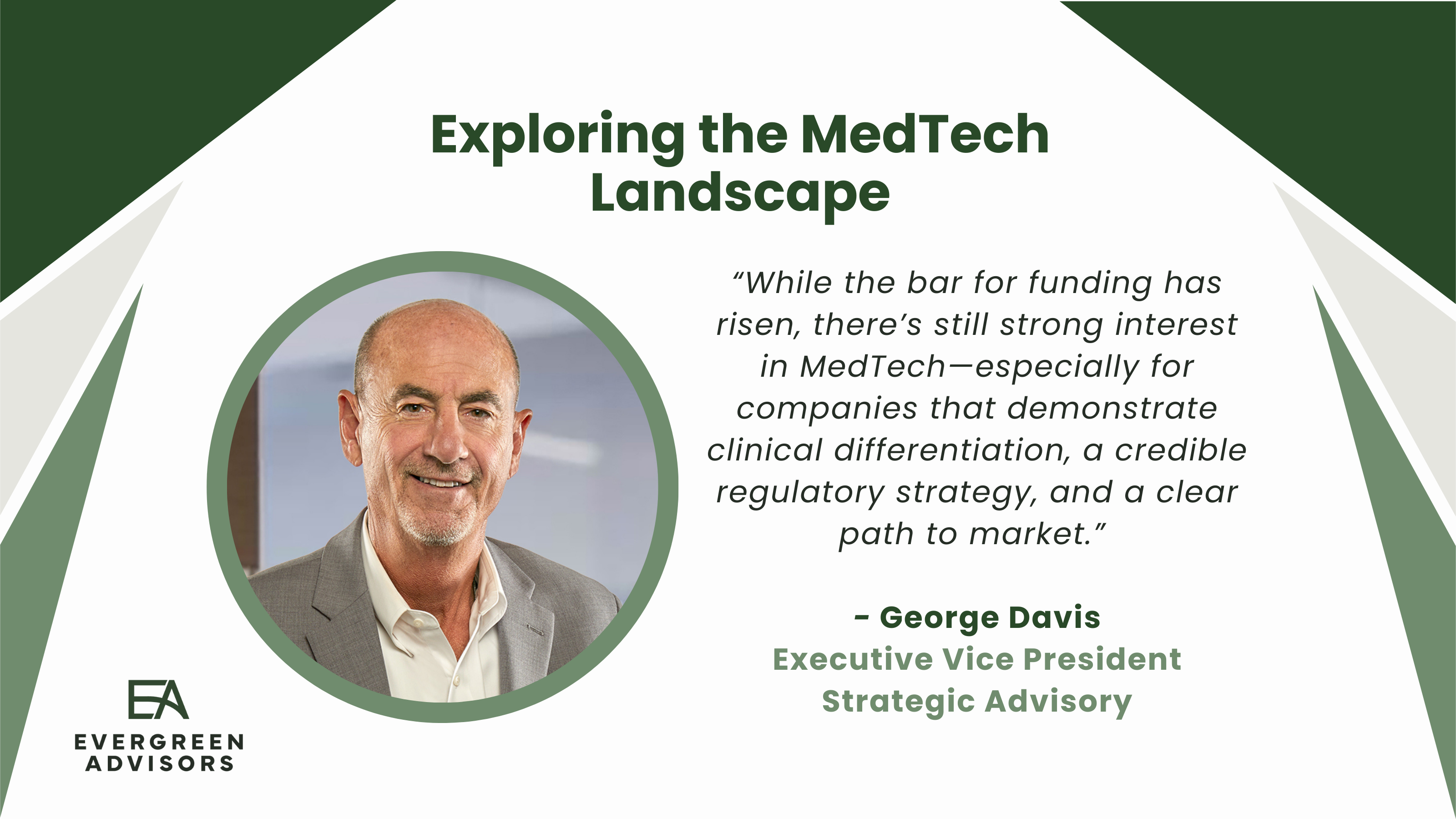Authored By: George Davis
April 2025 marked a pivotal moment for the medical technology sector as innovators, investors, researchers, and policymakers gathered across the state for Maryland MedTech Week, held from April 7–11. Anchored by the Maryland MedTech Summit at the University of Maryland, College Park, the week showcased the region’s growing influence in life sciences, diagnostics, digital health, and medical devices.
Among the standout moments was a panel discussion on “Institutional Funding Trends and Outlook 2025,” featuring George Davis, Executive Vice President at Evergreen Advisors and Fund Manager of Wexford SciTech Venture Fund. With deep expertise in early-stage MedTech investing, Davis shed light on the evolving capital landscape and what it takes for companies to attract institutional funding in today’s environment.
“While the bar for funding has risen, there’s still strong interest in MedTech—especially for companies that demonstrate clinical differentiation, a credible regulatory strategy, and a clear path to market,” Davis noted.
As the sector pushes ahead, companies continue to face a range of hurdles—from navigating regulatory frameworks and reimbursement models to addressing cybersecurity, sustainability, and workforce shortages. Yet with each challenge comes opportunity.
Below, we explore 10 pressing issues facing MedTech companies today, paired with the innovative ways they’re meeting them head-on.
1
Regulatory Complexity and Compliance
Bringing a medical device to market requires navigating a maze of global regulations. In the U.S., the FDA has tightened its review standards, while in Europe, the MDR (Medical Device Regulation) has introduced new clinical evaluation requirements, causing delays and added costs.
Compounding the issue, companies must ensure data privacy and cybersecurity compliance under frameworks like HIPAA and GDPR.
Innovative Paths to Regulatory Confidence



2
Rising Costs & Reimbursement Barriers
From R&D and clinical trials to navigating regulatory hurdles, the cost of bringing a MedTech product to market has skyrocketed.
At the same time, reimbursement policies often lag behind innovation, making it difficult for new products to get covered by insurance and public payers.
Driving Value While Reducing Friction



3
Cybersecurity Threats to Connected Devices
With the rise of the Internet of Medical Things (IoMT), everything from pacemakers to insulin pumps is becoming connected—and more vulnerable.
Healthcare providers are also prime targets for ransomware attacks, threatening patient safety and institutional integrity.
Building Resilience into Connectivity:



4
Persistent Supply Chain Disruption
COVID-19’s ripple effects are still being felt in the supply chain, especially in the availability of microchips and critical raw materials.
Many MedTech firms remain dependent on a small group of overseas suppliers, increasing their vulnerability to global disruptions.
Strengthening Supply Chain Agility:



5
AI & Tech Integration Challenges
AI holds huge promise in diagnostics, surgery, and patient monitoring, but many solutions face interoperability hurdles and resistance from clinicians.
Systems often don’t communicate with each other, and some providers are hesitant to trust algorithms they don’t fully understand.
Accelerating Adoption Through Transparency and Trust:



6
Workforce Shortages Across MedTech Roles
The industry is facing a shortage of skilled professionals—from AI engineers to regulatory experts to clinical specialists.
Retention is also an issue, with high competition across sectors and burnout among healthcare-aligned professionals.
Fueling the Future Workforce:



7
Ethical & Legal Uncertainty in AI Adoption
As AI becomes more embedded in decision-making, concerns are growing over accountability.
Who is responsible if an algorithm misdiagnoses a patient? And how do companies ensure their models don’t encode bias that could worsen health disparities?
Pioneering Ethical AI Frameworks:



8
Intensifying Market Competition & Consolidation
The global MedTech landscape is changing rapidly. Large firms continue to absorb promising startups, which may stifle innovation.
Meanwhile, lower-cost entrants from China and India are gaining market share with disruptive pricing strategies.
Turning Competition into Growth:



9
Environmental Pressures & Sustainability Demands
The healthcare industry is a major contributor to global waste and carbon emissions.
MedTech firms are facing pressure to improve sustainability—from using recyclable materials to reducing energy-intensive processes.
Leading the Charge in Green Innovation:



10
Evolving Patient Expectations
Today’s patients are more informed and engaged. They want personalized care, convenient home-based solutions, and ownership over their health data.
Companies must adapt to these new expectations or risk becoming obsolete.
Empowering the Modern Patient:



The Road Ahead for MedTech
According to Scott Whitacker, CEO of AvaMed, “MedTech is an economic powerhouse for America supporting 3 million jobs directly and indirectly and pays 37% higher than the medium American Job. With 95% of MedTech occurring here we are ensuring that the Unites Sates remains the global leader in medical innovation.”
The true future of MedTech lies in the integration of data, devices, and people. As companies align technological innovation with ethical and operational rigor, expect to see:
- AI-driven diagnostics and surgical robotics reach new heights
- Remote care accelerated by 5G connectivity
- 3D-printed implants and biofabrication revolutionize treatment delivery
- Global regulatory harmonization to ease international expansion
Maryland MedTech Week 2025 served as a powerful reminder of the state’s leadership in the healthcare innovation space. Through candid dialogue, new partnerships, and a shared commitment to better care, the MedTech community continues to push boundaries—for Maryland and beyond.
If you have any questions on the topics discussed in this article around MedTech, don’t hesitate to reach out to our team today.


